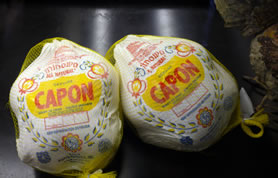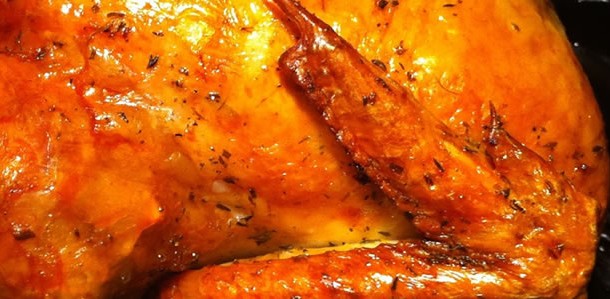- 1 Capon
- Brine:
- 1 cup salt
- 1/2 cup sugar
- Stuffing:
- 1/2 cup unsalted butter
- 1 good-quality day-old white french bread loaf, torn into 1" pieces (about 6 cups)
- 1 medium yellow onion chopped
- 2 ribs celery with leaves, chopped
- 1/4 cup flat-leaf parsley, chopped
- 1 tablespoons finely chopped fresh sage
- 1 teaspoon finely chopped fresh rosemary
- 1 teaspoon finely chopped fresh thyme
- 1 teaspoons kosher salt
- 1/2 teaspoon freshly ground black pepper
- 1 cup chicken stock
- 1 large egg
- Gravy:
- 4 cups chicken stock
- 1/2 medium onion, chopped
- 1 rib celery, chopped
- 1 medium carrot, chopped
- 2 tablespoons butter
- 1 teaspoon cornstarch
Roasted Capon, a castrated rooster, is like chicken’s richer cousin. It is tender, flavorful, moist and absolutely delicious. Caponization (castration) allows more fat to build up both below the skin and within muscle. Capons are plump and come with the promise of a substantial amount of buttery, tender meat. The flavor is unusually rich and complex, distinct from any chicken or turkey you’ve ever had before, and the texture is both moist and firm.
So, dear reader, true to our mission to introduce you to the new foods available to you in practically every mega mart, we present to you, the Capon. After years of bland chickens and dried-out holiday turkeys, let me assure you, a taste of capon will convert you instantly to this long forgotten French luxury.
You can find capons in your neighborhood mega mart in the same section where you find frozen turkeys and other frozen fowl. A typical capon is between 7.5 to 8 pounds. Substantially larger than an average chicken and smaller yet than your average turkey, a roasted capon will easily feed seven to eight people. One of the best things about roasting a capon is the ability to safely stuff the bird. Because of it’s size, the stuffing will reach a safe temperature and deliver a moist and delicious yield.
As with frozen turkeys, I’m a big fan of defrosting the bird in the refrigerator. It takes about 2 days. You can accelerate the process by submerging the bird in its original wrapper in cold water allowing about 30-minutes per pound.
What we are going to be doing here is pretty straight forward. We’ll be making a stuffing for our capon, stuffing it and roasting it to a golden perfection. While our capon is roasting, we’ll be making a gravy to serve along side that will knock your socks off. But to get there we need to learn a new technique called brining that will make any pork or fowl juicier than you ever thought possible.
When you cook any type of muscle fiber, moisture loss is inevitable. Normally, meat loses about 30 percent of its weight during cooking. But if you soak the meat in a brine composed of water, salt and sugar before cooking, you can reduce this moisture loss.
Brining enhances juiciness in several ways. First of all, muscle fibers simply absorb liquid during the brining period. Some of this liquid gets lost during cooking, but since the meat is in a sense more juicy at the start of cooking, it ends up juicier. Brined meats typically weigh six to eight percent more than they did before brining.
Another way that brining increases juiciness is by dissolving some proteins. A mild salt solution can actually dissolve some of the proteins in muscle fibers, turning them from solid to liquid – more moisture.
But of all the processes at work during brining, the most significant is salt’s ability to denature proteins on the surface. Simply put, proteins look like tightly wound springs bonded together. However, the space between the bonds is large enough to allow the moisture trapped in the muscle to escape during cooking. The dissolved salt in the brine causes some of the proteins in muscle fibers near the surface of the meat to unwind and swell. As they unwind, the bonds that had held the proteins together as a bundle break and muddle up together. This muddling of unwound proteins on the surface of the meat traps the water, prohibiting it from escaping. As long as you don’t overcook the meat, which would cause protein bonds to tighten and squeeze out a lot of the trapped liquid, these delicious natural juices will be retained.
To brine your capon, place the defrosted capon in a large container and cover with at least 13 cups water. Stir in 1 cup of salt and 1/2 cup sugar. Cover and allow to brine for 24-hours.
Directions:
- For stuffing, scatter bread pieces in a single layer on a rimmed baking sheet. Bake at 250 degrees, stirring occasionally, until dried out, about 30-40 minutes. Let cool and transfer to a large bowl.
- Meanwhile, melt butter in a large skillet over medium-high heat. Add onions and celery stirring often until just beginning to brown. Add to bowl with bread and stir in chicken stock, herbs, salt, and pepper. Let the stuffing cool.
- Remove giblets (neck, heart and gizzard – discard liver) from the capon and reserve. On the sides of the capon’s cavity you should find 2 large pieces of fat – one on either side. Remove these with a sharp knife and reserve.
- Preheat oven to 425 degrees.
- Rinse capon and pat dry with paper towels. Season the capon generously with Kosher salt and fresh ground black pepper including inside the cavity.
- Stuff the cavity of the capon with the stuffing.
- Using kitchen twine, tie the ends of the legs together. Then, wrap a longer piece of twine around the upper part of the capon in order to secure the wings to the breast and keep them from drying out.
- Place capon in a roasting pan with 1 cup water and roast for 20 minutes. Turn the heat down to 375 degrees and continue to roast until an instant-read thermometer inserted into the thickest part of the thigh reads 165 degrees to 170 degrees, count on this taking up to 2 hours. Baste the capon with pan drippings several times while roasting. Remove the capon to a platter and let stand for 20 minutes so the juices settle back into the meat before carving. Reserve to pan drippings for gravy as follows:
- Once the capon is in the oven, place a heavy 3-quart pot over a medium-high heat and add the reserved pieces of fat. Once the fat has begun to render, add reserved giblets and brown completely on all sides.
- Once the giblets are browned, remove from pot and reserve. Add onions, celery and carrots stirring until they just begin to take on color.
- Return the browned giblets to the pot and add 4 cups chicken stock. Bring to a slow simmer and allow to reduce in volume by half.
- Once the capon finishes roasting, we want to add the pan drippings to our gravy. Skim the grease off the pan drippings and add about 1/4 cup water to the pan. Using a wooden spoon, scrub all the dark bits off the bottom of the pan then pour into the simmering gravy.
- Bring gravy back to a medium boil and add butter. Dissolve corn starch in 3 tablespoons water , cut the heat and whisk into gravy. Serve along side carved capon and stuffing.





